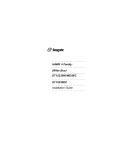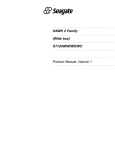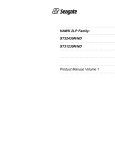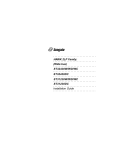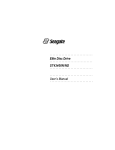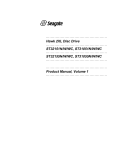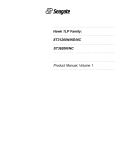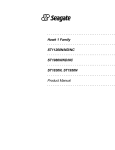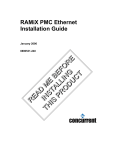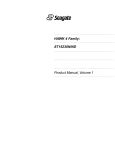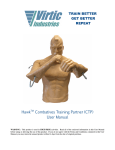Download Seagate HAWK 2 ST12400W/WD/WC Install guide
Transcript
Hawk 2 (Wide bus) Family Install Guide, Rev. C ....................... HAWK 2 Family: ....................... (Wide Bus) ....................... ST12400W/WD/WC ....................... ST11900W/WD/WC ....................... Installation Guide ....................... Hawk 2 (Wide bus) Family Install Guide, Rev. C Contents Introduction ........................................................... 1 Electromagnetic interference ................................ 1 Before you begin .................................................. 3 Installation overview ....................................... 8 Product repair information .................................... 10 Shipping ......................................................... 11 Product repair and return information ............. 11 Technical support services ............................. 12 Drive specifications ............................................... 15 Initial set-up information ........................................ 18 Drive configuration ................................................ 23 Drive installation ................................................... 33 © 1995 Seagate Technology, Inc. All rights reserved Publication Number: 77767465, Rev. C March 1995 Seagate®, Seagate Technology® and the Seagate logo are registered trademarks of Seagate Technology, Inc. HawkTM, SeaFAXTM, SeaFONETM, SeaTDDTM and SeaBOARDTM are trademarks of Seagate Technology, Inc. Other product names are registered trademarks or trademarks of their own. Seagate reserves the right to change, without notice, product offerings of specifications. No part of this publication may be reproduced in any form without written permission from Seagate Technology, Inc. Hawk 2 (Wide bus) Family Install Guide, Rev. C 1 Introduction Before attempting any installation, please read through all applicable sections of this document, including all warnings and cautions. Warning. This equipment generates, uses, and can radiate radio frequency energy and if not installed in accordance with these instructions, may cause interference to radio communications. Electromagnetic interference (EMI) considerations The drive(s) described herein, as delivered, are designed for system integration and installation into a suitable enclosure prior to use. As such, the drive(s) described herein are supplied as a sub-assembly and are not subject to Subpart J of Part 15 of the FCC Rules and Regulations nor the Radio Interference Regulations of the Canadian Department of Communications. However, the unit has been tested using proper shielding and grounding and found to be compliant with the Class A limits of the FCC Rules and the Regulations of the Canadian Department of Communications. 2 Hawk 2 (Wide bus) Family Install Guide, Rev. C The physical design characteristics of the drive(s) described herein, serve to minimize EMI radiation when installed in an enclosure that provides reasonable shielding. As such, the drive(s) are capable of meeting the Class B limits of the FCC Rules and the Regulations of the Canadian Department of Communications. Note. It is the end users' responsibility to assure that the drive(s) described herein meet the appropriate EMI requirements of their system. Shielded I/ O cables may be required if the enclosure does not provide adequate shielding. If I/O cables are external to the enclosure, shielded cables should be used, with the shields grounded to the enclosure and to the host controller. Hawk 2 (Wide bus) Family Install Guide, Rev. C 3 Before you begin Verify that the system is switched off and disconnected from main power before any installation is attempted. Protect yourself, the drive, and your valuable programs and data by reading the following cautions and warnings. • Do not unpack drive from its static shielded bag until you are ready to install it in the system. • Always handle the drive by the frame or casting. • Do not touch printed circuit board (PCB) or the I/O connector pins. • Never apply pressure to the PCB or to the drive top cover. • Do not tamper with sealed top cover. Doing so voids your warranty. The drive contains no user serviceable components. See Product Repair section for more information. • Visually inspect the shipping container for any obvious damage. 4 Hawk 2 (Wide bus) Family Install Guide, Rev. C • Inspect drive for possible shipping damage. All claims of this type should be filed promptly with the transporter involved. Save original packing materials to be used when reshipping. • Verify all parts listed on shipping bill are received with the equipment. Discrepancies or damage should be reported to the shipping company. • When transporting or shipping a drive or system, please ensure that they are correctly packed in original Seagate approved (or equivalent) container and shipped via an air-ride carrier experienced in handling computer equipment. Caution. The circuit assemblies and components contained in this equipment can be degraded or destroyed by Electrostatic Overstress (EOS) or by Electrostatic Discharge (ESD). Static electrical charges can accumulate quickly on personnel, clothing and synthetic materials. The electrostatic fields due to these charges when brought in close proximity to susceptible circuit assemblies and components, can result in degraded reliability or immediate failure of the affected component or assembly. Hawk 2 (Wide bus) Family Install Guide, Rev. C 5 To insure optimum reliable equipment operation, it is required that technical support personnel discharge themselves by wearing a grounding strap around the wrist and be connected to a grounding terminal while working in the vicinity of, and while handling EOS/ESD susceptible assemblies/parts. If unavailable, ground yourself frequently by touching the metal chassis of the system before handling any components (this helps only if the system is connected to a ground). Avoid static-inducing carpeted areas. This procedure is especially important when handling printed circuit boards (PCBs). 6 Hawk 2 (Wide bus) Family Install Guide, Rev. C Safety instructions 1. The disc drive(s) are to be installed in a customer supplied enclosure where the surrounding air does not exceed 50oC. 2. Four (4) 6-32 UNC-2A screws are required for installation. Maximum screw length into side of drive is 0.15 inches (3.81 mm). Maximum screw length into bottom is 0.20 in. (5.08 mm). Maximum screw tightening torque is 8.0 in-lb (.90 NM) with minimum thread engagement of .12 in. (3.0 mm). 3. The power requirements are shown in Section 1.0 Product Information. 4. The power supply must satisfy the safety requirements for SELV (Safety Extra Low Voltage) circuits. 5. Service is to be provided by trained Seagate service personnel. 6. The incorporation of the disc drives listed in this guide into a customer enclosure must meet the appropriate safety requirements of the country in which it is used (e.g. UL 1950, CAN/CSA-C22.2 No. 950-M89, DIN VDE 0805/05.90 and EN60950: 1988 (IEC 950). Hawk 2 (Wide bus) Family Install Guide, Rev. C Sicherheitsanleitung 7 1. Däs Gerät ist ein Einbaugerät, vorgesehen für eine maximale Umgebungstemperatur von 50oC. 2. Zur Befestigung der Drive werden 4 Schrauben benötigt (6-32 UNC-2A). Die maximale Länge der Schrauben in der unteren Seite des Chassis darf nicht mehr als 0.20 in (5.08 mm) betragen, die in der oberen 0.15 in (3.81 mm). Maximalle Schraubenanziehung von 8.0 in-lb. (.90 NM) mit minimalen Gewindeansperuch .12 in. (3.00 mm). 3. Die Versorgungsspannungen werden im Kapitel 1.0 (Produkt Information) gezeigt. 4. Die Versorgungsspannung muss SELV entsprechen. 5. Alle Arbeiten dürfen nur von ausgebildetem Seagate Service-Personal durchgefürhrt werden. 6. Der Einbau des Drives muss den Anforderungen gemäss DIN VDE 0805/05.90 oder EN60950: 1988 (IEC 950). 8 Hawk 2 (Wide bus) Family Install Guide, Rev. C Installation Overview Installation of the drive can be divided into distinct phases as outlined below. Some of these may not be applicable to your particular installation requirements. Refer to the individual drive installation sections for specific information on your drive model. • Drive configuration: The user must select which of the drive features are appropriate to enable for installation in their system. This is done by way of the user configuration jumpers found on the drive PCB. • Mechanical installation: After setting up the drive configuration the drive must be mechanically installed into the host system and the power and I/ O cables attached. Previously mentioned precautions should be observed • SCSI drives should not be defined in the CMOS: The SCSI Host adapter has its own BIOS to handle the Input/output procedures. The CMOS setting for SCSI drive is either drive type zero, or the "no drive installed" option. Hawk 2 (Wide bus) Family Install Guide, Rev. C 9 • Low-level formatting: After the drive has been properly configured for the system, it does not need to be low-level formatted, as this has been done by the factory and does not require this step during installation. (The low-level format writes the sector boundaries and track information to the drive). Defect management information is read from the drive by the host system when required in the installation procedure. If an installed drive is low-level formatted, all user data stored on the drive will be lost. Note. Seagate Technology assumes no liability for lost user data. • Partitioning and high level formatting: A drive can be sub-divided into "partitions" which behave as individual drives within the system. See your system documentation. Present day drive installation programs have menus that lead you through these installation procedures. 10 Hawk 2 (Wide bus) Family Install Guide, Rev. C Product repair information Service requirements The special facilities required for the manufacture of these drives generally prohibit repair in the field. If problems occur during installation, please contact your supplier for assistance. Do not attempt to disassemble or repair. Drives should be sent to the repair depot through the purchase source, if possible. Please observe the following cautions. Caution. • Handle drive with care. Do not drop or bump hard. • Never remove the cover of these disc drives. Servicing items in the sealed HDA (heads, media, actuator, etc.) require special facilities. The drive contains no user purchasable parts or PCBs. • Opening the sealed HDA voids the drive warranty. • Applying a soldering device to the components on the PCB voids the drive warranty. Hawk 2 (Wide bus) Family Install Guide, Rev. C 11 • Place drive on a flat, static dissipative surface and handle with extreme care. Always follow all EOS/ ESD precautions to avoid damage to the electrical assemblies. Shipping: When transporting or shipping a drive, a Seagate approved container must be used. Keep your original box. They are easily identified by the Seagate Approved Package label. Shipping a drive in a nonapproved container voids the drive warranty. Seagate repair centers may refuse receipt of components improperly packaged or obviously damaged in transit. Contact your Authorized Seagate Distributor to purchase additional boxes. Seagate recommends shipping by an air-ride carrier experienced in handling computer equipment. Product repair and return information Seagate customer service centers are the only facilities authorized to service Seagate drives. Seagate does not sanction any third-party repair facilities. Any unauthorized repair or tampering with the factory-seal voids the warranty. Warranty: Contact your Seagate Authorized Distributor, Dealer or other purchase source for warranty information. 12 Hawk 2 (Wide bus) Family Install Guide, Rev. C If the drive is no longer under warranty contact purchase source for repair information or refer to numbers listed in the following paragraph . Technical support services Please contact your dealer for technical support and installation troubleshooting. Product Technical Support is available for all Seagate products by calling the SeaFAX, SeaFONE, SeaTDD or SeaBOARD services. These are toll calls. SeaFAX: 408/438-2620 You can use a Touch-Tone telephone to access Seagate's automated FAX delivery system and select technical support information by return FAX. This service is available 24 hours a day, 7 days a week. SeaFONE: 408/438-8222 The enhanced phone system provides recorded technical information on selected Seagate products while you are on hold. Technical support specialists are available to answer questions from 8:00 AM to 5:00 PM PST, Monday through Friday. Recordings are accessible 24 hours a day, 7 days a week. Hawk 2 (Wide bus) Family Install Guide, Rev. C 13 SeaTDD: 408/438-5382 TDD is a Telecommunication Device for the Deaf where two people can communicate using a keyboard that is connected to the phone line. A TDD device is required to access this service. This service is available from 8:00 AM to 5:00 PM PST, Monday through Friday. SeaBOARD: The Seagate Technical Support Bulletin Board System (BBS) is available 24 hours a day, 7 days a week. A modem is required to access this service. The communications software must be set for eight data bits, no parity and one stop bit (8N1). 14 Hawk 2 (Wide bus) Family Install Guide, Rev. C With this service you can access: • Specifications and jumper configurations for all Seagate products. • Reprints of Seagate documentation. • A directory of information and helpful utilities that you can download to your own computer. BBS Location United States England Germany Singapore Australia Modem Number 408-438-8771 44-62-847-8011 49-89-140-9331 65-227-2217 61-2-756-2359 Note: These are toll calls Maximum Baud Rate 9600 9600 2400 9600 9600 Hawk 2 (Wide bus) Family Install Guide, Rev. C 15 Drive specifications Product Hawk 2 family (wide) Information ST12400W/WC ST12400WD Interface [7] SCSI-2 Fast SCSI-2 Fast Cache Type Multi-segmented, 256 Kb* Capacity MB Unformatted 2537 2537 Formatted [1] 2148 2148 Cylinders 2621 2621 Heads 19 19 Sectors/track (Avg.) 84 84 Recording method RLL (1,7) RLL (1,7) Rev/min 5411 5411 Seek time (ms typ.) [2] Average Read 9.3 9.3 Write 10.8 10.8 Operating environment Ambient temp. [4] ------ 5oC to 50oC----HDA max temp. [3] -----------60oC---------Power requirements (Versorgungsspannungen) +12 V+/-5% (Max [6] 1.0 A 1.0 A (Max Start) [5] 2.4 A 2.4 A +5 V +/-5% (Max) [6] 1.0 A 1.2 A Power Idle (Typ) 9.0 W 10.8 W Oper. (Typ) 12.1 W 14.6 W *Optional 1 MB 16 Hawk 2 (Wide bus) Family Install Guide, Rev. C Product Hawk 2 family (wide) Information ST11900W/WC ST11900WD Interface [7] SCSI-2 Fast SCSI-2 Fast Cache Type Multi-segmented, 256 Kb* Capacity MB Unformatted 2003 2003 Formatted [1] 1700 1700 Cylinders 2621 2621 Heads 15 15 Sectors/track (Avg.) 84 84 Recording method RLL (1,7) RLL (1,7) Rev/min 5411 5411 Seek time (ms typ.) [2] Average Read 9.3 9.3 Write 10.8 10.8 Operating environment Ambient temp. [4] ------5oC to 50oC-----HDA max temp. [3] -----------60oC---------Power requirements (Versorgungsspannungen) +12 V+/-5% (Max [6] 1.0 A 1.0 A (Max Start) [5] 2.4 A 2.4 A +5 V +/-5% (Max) [6] 1.0 A 1.2 A Power Idle (Typ) 9.0 W 10.8 W Oper. (Typ) 12.1 W 14.8 W *Optional 1 MB Hawk 2 (Wide bus) Family Install Guide, Rev. C 17 Notes. [1] Standard units are factory formatted with 512 data bytes per sector. ST12400 OEM standard models have twelve spare sectors per cylinder and 2 cylinders at inner tracks reserved for spares. The model ST11900 has six spares per cylinder and 2 spare cylinder per unit. [2] Does not Include on-board controller overhead. [3] Maximum measured at any location on top cover. [4] For best reliability keep below 35oC (95oF). [5] A droop of up to -10% is permissible for a maximum of 10 seconds at power up. (abfall von -10% ist erluabt für 10 Sekunden max). [6] Measured with an average reading DC ammeter. Instantaneous +12 V current peaks will exceed these values. [7] Can be commanded to operate according to SCSI1 protocol. 18 Hawk 2 (Wide bus) Family Install Guide, Rev. C Initial setup information For the initial setup connect the cables, set the SCSI bus address and enable or disable (as required by system configuration), the SCSI I/O line terminator resistors (model "W" drives only). Note whether the drive model number ends in W, WC or WD. These procedures are described in paragraphs following. SCSI interface cable connection The drives covered by this manual are SCSI interface drives. For "W" and "WD"" models, system connection is via a 68 pin, SCSI connector. For "WC" models system connection is via an 80 pin SCSI connector. Normally "WC" models plug directly into a PCB or bulkhead mounted mating 80 pin connector. Pin 1 is noted in Figures 1a and 1b. Some cables have a contrasting color stripe on one edge to indicate pin 1. The I/O connector is keyed by virtue of its shape. There is only one way it can mate with the mating input connector. Strain relief is recommended at the cable for drives using cables. Do not block system cooling air flow in routing of cables. DC Power connection Model ST12400W/WD family drives receive DC power through a 4 pin connector mounted on the PCB next to the SCSI I/O connector. See Figure 1. Hawk 2 (Wide bus) Family Install Guide, Rev. C J1 J1-Auxiliary 68 Pin SCSI I/O Connector 4P 3P 2P 1P DC Power Connector Pin 1P 2P 3P 4P 19 Power +12V +12V ret + 5V ret + 5V Figure 1. DC power connection, 68 pin SCSI I/O connector Model ST12400WC model drives receive power from the host computer through the 80 pin combined SCSI I/O and power connector (not shown, since a separate DC power cable not required). No separate DC power connector is provided on the drive. SCSI address selection On "W" and "WD" model drives, make sure that the SCSI bus address jumper plugs are properly set for the bus address assigned to the drive. In some systems, a cable plugs into either J6 or J1auxiliary, so drive ID can be set at some remote location. See figures 3a and 3b showing the bus address select header and the jumper configurations that select addresses 0 through 15. Typically the primary boot device is set to ID 0, and the subsequent SCSI drives are jumpered in ascending order. Bus addresses 0 through 14 should be used (the host adapter probably uses address 15). 20 Hawk 2 (Wide bus) Family Install Guide, Rev. C If the drive LED shows no on/off activity when the host is trying to communicate with it, an incorrect bus address selection at the drive (or remote ID select location) should be suspected. On "WC" model drives the SCSI ID can be and presumably will be, set over the 80 pin interface by the host computer. Unless directed to do so by the system documentation, no jumpers should be installed for address selection. On "WC" model drives, the host system also has complete control over motor start functions, so no Motor Start or Delayed Motor Start Jumpers should be installed. Terminator resistor packs Model ST12400W family drives have I/O line terminator resistors that are permanently installed, but can be enabled or disabled by jumper plug. See jumper in Figure 3a. If you are installing a single drive, the terminator resistors must remain enabled. If you are installing multiple hard disc drives, disable the termination resistors from all the drives but the one connected to the end of the SCSI I/O cable. Hawk 2 (Wide bus) Family Install Guide, Rev. C 21 Model numbers that end in "WD" have differential I/O circuits and these drives and "WC" mode drives have no provisions for terminators on the drive PCB. The system manufacturer must provide some external means of I/O line termination. The ST12400W/WD drives can provide power for external terminators if the TP jumper is installed on the last position on the right end of J2. See Figure 3a. Read/Write head auto-park Seagate disc drives described herein mentioned in this drive park the heads automatically at power off. This feature requires no operator intervention. Optional parity bit enable Some systems require parity bit checking. Consult the system documentation for the specific requirements. See Figure 3a for location of Parity Bit enable jumper. Jumper-installed enables parity reporting by the SCSI bus. Write precompensation and reduced write current Not required on Seagate SCSI Interface drives covered by this manual. 22 Hawk 2 (Wide bus) Family Install Guide, Rev. C J1-Auxiliary Pin 1A J1-DC Power Pin 1P J1 Pin 1 J2 68 Pin SCSI I/O Connector J6 Figure 2a. Hawk 2 family ST12400W/WD model I/O connection 68 pin SCSI I/O and DC power connector). Terminators are not provided. J2 80 Pin SCSI I/O and DC Power Connector Pin 1 J6 Figure 2b. Hawk 2 family ST12400WC model drive physical interface (80 pin SCSI I/O and DC power connector). Terminators are not provided. Hawk 2 (Wide bus) Family Install Guide, Rev. C 23 Drive configuration Each disc drive has option select header connectors on the back, side and front where jumper plugs are installed to select the way that the drive is to be configured and to select its ID (0 - 15) on the I/O bus. See notes following Figure 3b. ST12400W/WD family 68 pin SCSI I/O drives On Hawk 2 family, W/WD model drives either J6 (on the front of the drive) or J1-auxiliary (at the rear, beside the DC Power connector) may be used to set the drive ID. To avoid possible incorrect ID setting, do not use both J1-auxiliary and J6 for ID selection. The following figures show where these headers are located on the different drives covered by this manual. See notes following Figures 3a and 3b where explanations are given about the purpose of each jumper and specify the standard factory (called "default") settings of these jumpers (i.e., settings used for most common single drive application). Changes to these settings should be made only if it is known that the system requires a different configuration. 24 Hawk 2 (Wide bus) Family Install Guide, Rev. C ST12400WC family 80 pin SCSI I/O drives On Hawk 2 family, ST12400WC model drives there is no J1-auxiliary. J6 can be used to set drive ID, but the host probably does it over the 80 pin interface. J6 may be used to drive external LED's and connect the synchronized spindle signal to other drives and the host. This is described in the notes following Figure 3b. Hawk 2 (Wide bus) Family Install Guide, Rev. C Drive with HDA up, PCB down, viewed from front HDA Pin 1 Pin 1 End SCSI I/O Connector J6 J1-SCSI I/O Drive Front J6 [2] SCSI ID = 0 J1-DC Power Connector J2 SCSI ID = 1 J1-Auxiliary See Figure 3b SCSI ID = 2 SCSI ID = 3 J2 SCSI ID = 4 Jumper Positions SCSI ID = 5 SCSI ID = 8 Delay Motor Start Enable Motor Start SCSI ID = 9 Write Protect SCSI ID = 10 Parity Option SCSI ID = 11 Enable Terminators Term. Power from Drive Term. Power to SCSI Bus Term. Power from SCSI Bus SCSI ID = 7 [3] SCSI ID = 12 SCSI ID = 13 SCSI ID = 14 SCSI ID = 15 A 3 A 2 A 1A 0 Alternate Useage: Pin 1 R E D M W P T T T S S E P E E P P Reserved SCSI ID = 6 +5V [2] [2] [5] [5] [6] [5] Position A Ground 11 9 7 5 3 1 [4] Connections to drive ID switching circuits in host equipment 150 Ω 1/8W Busy 150 Ω 1/8W Vendor Unique 150 Ω 1/8W 25 SSP Dashed area is optional user circuitry external to the drive External Fault Figure 3a. Drive configurator Hawk 2 family ST12400W/WD model (Wide bus) family 26 Hawk 2 (Wide bus) Family Install Guide, Rev. C 68 Pin SCSI I/O J1-Auxiliary Pin 1 Pin 1A [2] J1-DC Power Connector 4P 3P 2P Drive HDA 1P J1 PCB SCSI ID = 0 SCSI ID = 1 SCSI ID = 2 SCSI ID = 3 SCSI ID = 4 SCSI ID = 5 SCSI ID = 6 [3] SCSI ID = 7 SCSI ID = 8 SCSI ID = 9 SCSI ID = 10 SCSI ID = 11 SCSI ID = 12 SCSI ID = 13 SCSI ID = 14 SCSI ID = 15 A 3 A 2 A 1A 0 +5V GND 11 9 7 5 3 1 Alternate Useage: [4] Connections to drive ID switching circuits in host equipment 150 Ω 1/8W Busy 150 Ω 1/8W Vendor Unique 150 Ω 1/8W SSP Dashed area is optional user circuitry external to the drive External Fault Figure 3b. Drive configurator Hawk 2 family ST12400W/WD model (Wide bus) family Hawk 2 (Wide bus) Family Install Guide, Rev. C Drive with HDA up, PCB down, viewed from front HDA 27 Pin 1 End Pin 1 J6 Drive Front J6 J1 A 3 A 2 A 1A 0 SCSI ID = 0 J2 SCSI ID = 1 SCSI ID = 2 Pin 1 J2 SCSI ID = 3 Jumper Positions SCSI ID = 4 SCSI ID = 5 Reserved SCSI ID = 6 Delay Motor Start Enable Motor Start SCSI ID = 7 SCSI ID = 8 R E D M W P S S E P E [7] Write Protect [7] SCSI ID = 9 Parity Option SCSI ID = 10 Not Used SCSI ID = 11 SCSI ID = 12 Not Used SCSI ID = 13 Not Used SCSI ID = 14 Not Used SCSI ID = 15 Sync Spindle [8] Remote LED Remote LED CATH Figure 3c. Drive configurator Hawk 2 family ST12400WC model (Wide bus) family 28 Hawk 2 (Wide bus) Family Install Guide, Rev. C Notes for Figure 3a, 3b and 3c: [1] Notes explaining the functions of the various jumpers on jumper header connectors J2, J1-auxiliary and J6 are given below in left to right order of jumper position. The term "default" means as standard OEM units are configured when shipped from factory. "Off" means no jumper is installed; "On" means a jumper is installed. Off or On underlined is factory default condition. [2] The PCB on "WC" models does not have connector J1auxiliary, but has a single 80 pin combined SCSI I/O and DC power connector instead of the 68 pin SCSI I/O and 4 pin DC power connectors. Included among the 80 pins are the SCSI ID, Motor Start and Delayed Motor Start select functions, and the synchronous spindle master sync signal and the remote LED signals. Do not use J2 and J6 for these five functions if the host uses the ones included in the 80 pin connector. [3] Drive ID may be established by installing jumper plugs in one of the patterns shown in Figures 3a, 3b and 3c, or by plugging onto J6 or J1-auxiliary a cable that leads to an external ID selection circuit. Both jumper plugs and an external ID selection source should not be used. See [4] for other functions of these two headers that are time-shared with the drive ID function. Hawk 2 (Wide bus) Family Install Guide, Rev. C 29 [4] The drive time-shares the ID and LED/SSP functions of J6 and J1-auxiliary. That is, a cable may be attached to one of these headers to pick up the synchronized spindle reference signal (SSP) and three signals that light external LED indicators. If lines for external ID selection are not also included in the cable, jumper plugs must be used on the header not having a cable connected in order to establish drive ID. The drive reads the ID from J6 and J1-auxiliary for 250 ms after poweron or drive reset, and then uses these headers for the LED and SSP functions the remainder of the time. Host system documentation should describe the application of the three LED indicators if it connects a cable to use this option. [5] Hawk 2 family model ST12400W and ST11900W only. [6] Applies to Hawk 2 family ST12400 and ST11900 W and WD models only. [7] Applies to Hawk 2 family ST12400WC and ST11900WC models only. J2 Jumper. Position RES Off/On DS ME Off Off Jumper Function Description Reserved. Default is no jumper installed. Spindle starts immediately after power up - Default setting. 30 Hawk 2 (Wide bus) Family Install Guide, Rev. C continued from previous page Off On On Off On On WP On Off PE On Off TE On Off Drive spindle does not start until Start Unit command received from host. Spindle Startup is delayed by SCSI ID times 12 seconds after power is applied, i.e., drive 0 spindle starts immediately when DC power connected, drive 1 starts after 12 second delay, drive 2 starts after 24 second delay, etc. Drive spindle starts when Start Unit command received from host. Delayed start feature is overridden and does not apply when ME jumper is installed. Entire drive is write protected. Drive is not write protected. Default is no WP jumper installed. Parity checking and parity error reporting by the drive is enabled. Default is PE jumper installed. Drive does not report result of parity checking to host. (Applies to "W" models only) With the jumper installed, the optional on-board (non-removable) terminator circuits are enabled (connected to the I/O lines). Default is jumper installed. Terminator circuits not connected to I/O lines. Hawk 2 (Wide bus) Family Install Guide, Rev. C 31 continued from previous page TP TP Off Off On Off Off On On On (Not applicable to "WC" model drives) No terminator power is connected to drive terminators or SCSI bus I/O pin 26. Drive supplies its own terminator power only. Jumper on this position is factory default. Drive supplies power to I/O pin 26 of SCSI bus; none to internal terminators. When drives have differential I/O circuits a jumper on the right TP position may be needed to power external terminator (see system documentation). The Hawk 2 family ST12400WD drive has differential I/O circuits which have no terminator circuits on the drive. Drive supplies terminator power to itself (internal connection) and to I/O pin 26 of SCSI bus. This is a legal jumper setting. TP Position A On This horizontally positioned jumper across the two TP positions nearest PCB edge, connects terminator power from SCSI bus I/O pin 26 to the drive's internal terminators (for single-ended I/O only). Off See above explanations for TP jumpers. 32 Hawk 2 (Wide bus) Family Install Guide, Rev. C J6 and J1-Auxiliary Jumper Installation Jumper Function Description A3,A2,A1,A0* Drive ID on SCSI Bus. The drive ID is binary coded positionwise i.e., jumper in position A3 is drive ID 8, in position A2 is drive ID 4, in position A1 is ID 2, position A0 is ID 1 and no jumpers is ID 0. Default is ID = 0. Either J1-auxiliary or J6 may be used to select drive ID. Both should not be used at the same time, because at some future time when the ID is changed the user could fail to configure both J1-auxiliary and J6 the same. Default is ID = 0. SSP* No jumper ever installed. Used only as a cable connection for the reference index signal (REFIND+) (J6 Pin 6, bottom) for sync spindle feature. J6 pin 10 is GRD. Installing a jumper between pins 5 and 6 will cause an erroneous drive ID indication. BUSY Connection for optional external Drive Busy indicator. VENDOR Connection for optional indicator for custom use. UNIQUE See host system documentation. EXTERNAL Optional indicator indicates some external to FAULT drive fault occurred. *See notes on page 28 and 29 Hawk 2 (Wide bus) Family Install Guide, Rev. C 33 Drive installation This section describes the physical mounting of the drive in the host cabinet and the logical installation as a system member, which is called drive setup. Disc drive mounting Do not touch the connector pins or any PCB components without observing static-discharge precautions. Always handle the drive by the frame only. The drive may be mounted in any orientation. • See notes on Figures 4 and 5 pertaining to proper drive installation. • Verify that all connections between the drive and the host system are correctly installed. Most cables have a contrasting color stripe indicating pin 1. Pin 1 on the drive I/O, J1-auxiliary DC power connectors are indicated in the figures in the Initial Set-up Information section. • Verify option select and drive ID select jumpers. See Drive Configuration section. 34 Hawk 2 (Wide bus) Family Install Guide, Rev. C G C [3] L [4] D [1] F E A Notes: [1] Mounting holes three on each side, 6-32 UNC. Max screw length into side of drive 0.15 in. (3.81 mm). Screw tightening torque 8.0 in-lb (.90 NM) max with minimum thread engagement of .12 in. (3.00 mm). [2] Mounting holes four on bottom, 6-32 UNC. Max screw length into bottom of drive 0.20 in. (5.08 mm). Screw tightening torque 8.0 in-lb (.90 NM) max with minimum thread engagement of .12 in. (3.00 mm). B J [3] Power and interface connections can extend past the "A" dimension by 0.040 in. (1.02 mm). [2] [4] Decorative front panel. Inches A B C H K P N [4] M D E F G H J K L M N P 5.74 ± 0.010 4.00 ± 0.010 1.620 + 0.026 – 0.021 2.362 ± 0.010 .620 ± 0.010 4.000 ± 0.010 .250 ± 0.018 1.750 ± 0.010 3.750 ± 0.010 2.370 ± 0.010 1.725 ± 0.010 4.100 ± 0.010 0.19 ± 0.010 0.015 max Millimeters 145.80 ± .25 101.60 ± .25 41.15 + .66 – .53 60.00 ± .25 15.75 ± .25 101.60 ± .25 6.35 ± .46 44.45 ± .25 95.25 ± .25 60.20 ± .25 43.82 ± .25 104.14 ± .25 4.83 ± .25 0.381 max Figure 4. Hawk 2 family ST12400W/WD model drive mounting dimensions (68 pin SCSI I/O connector) Hawk 2 (Wide bus) Family Install Guide, Rev. C G C [3] L [4] D [1] 35 F E A Notes: R [1] Mounting holes three on each side, 6-32 UNC. Max screw length into side of drive 0.15 in. (3.81 mm). Screw tightening torque 8.0 in-lb (.90 NM) max with minimum thread engagement of .12 in. (3.00 mm). [5] Pin 1 [2] Mounting holes four on bottom, 6-32 UNC. Max screw length into bottom of drive 0.20 in. (5.08 mm). Screw tightening torque 8.0 in-lb (.90 NM) max with minimum thread engagement of .12 in. (3.00 mm). B Connector Centerline J [3] Power and interface connections can extend past the "A" dimension by 0.040 in. (1.02 mm). [4] Decorative front panel. [5] Connector is centered (side to side) on drive within ±0.020 in. (.508 mm). [2] A B C H K P N [4] M D E F G H J K L M N P R Inches Millimeters 5.74 ± 0.010 4.00 ± 0.010 1.620 + 0.026 – 0.021 2.362 ± 0.010 .620 ± 0.010 4.000 ± 0.010 .250 ± 0.018 1.750 ± 0.010 3.750 ± 0.010 2.370 ± 0.010 1.725 ± 0.010 4.100 ± 0.010 0.19 ± 0.010 0.015 max 0.181 + 0.018 – 0.013 145.80 ± .25 101.60 ± .25 41.15 + .66 – .53 60.00 ± .25 15.75 ± .25 101.60 ± .25 6.35 ± .46 44.45 ± .25 95.25 ± .25 60.20 ± .25 43.82 ± .25 104.14 ± .25 4.83 ± .25 0.381 max 4.597 + .45 – .33 Figure 5. Hawk 2 family ST12400WC model drive mounting configuration dimension (80 pin I/O connector) 36 Hawk 2 (Wide bus) Family Install Guide, Rev. C Do not power up the host system until the drive is mounted and the system cover is replaced. • Connect DC power connector to the drive. (does not apply to "WC" models) • Replace the Host System cover. • Turn on DC power. • Boot the system from the floppy drive or from a previously installed hard-drive if there is one. • Proceed with drive setup of the new hard drive. Grounding Signal ground (PCB) and HDA ground are connected together in the Hawk 2 (Wide bus) drive and cannot be separated by the user. The equipment in which the drive is mounted is connected directly to the HDA and PCB with no electrically isolating shock mounts. If it is desired for the system chassis to not be connected to the HDA/PCB ground, the systems integrator or user must provide a nonconductive (electrically isolating) method of mounting the drive in the host equipment. Hawk 2 (Wide bus) Family Install Guide, Rev. C 37 SCSI interface drives The SCSI interface handles both drive geometry and defect management internally. The "no drive installed" option is selected for systems with SCSI drives. All SCSI interface drives are low-level formatted at the factory. You may wish to low-level format the drive to optimize its performance for your system. Consult the controller documentation for information on low-level formatting. Partitioning and high-level formatting can be done through DOS by way of the FDISK utility for partitioning, and FORMAT for high-level formatting. Consult your DOS manual for FORMAT and FDISK command options. Hawk 2 (Wide bus) Family Install Guide, Rev. C Seagate Technology, Inc. 920 Disc Drive Scotts Valley, CA. 95066-4544, USA Publication Number: 77767465, Rev. C Printed in USA








































